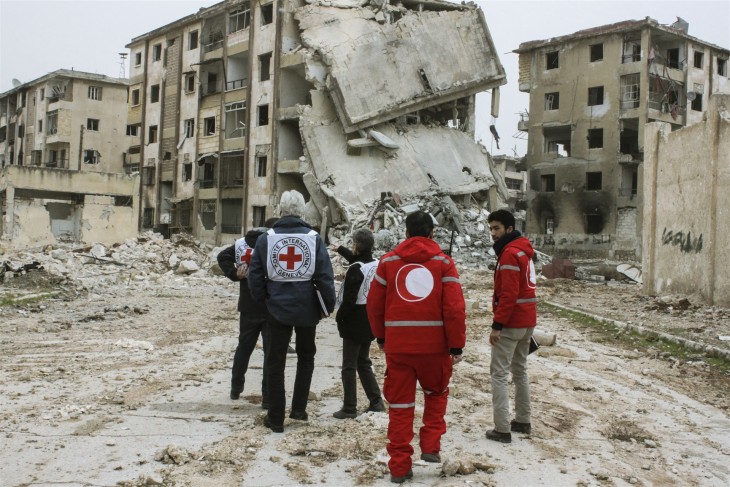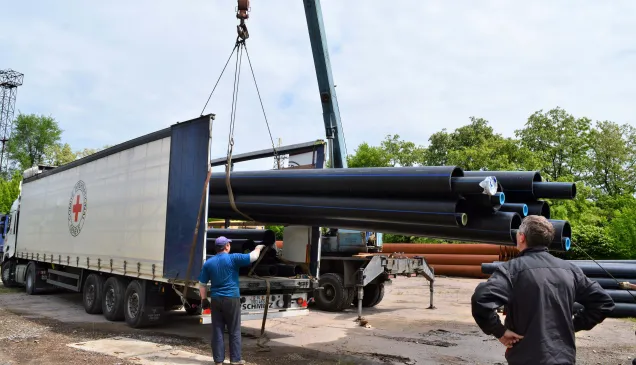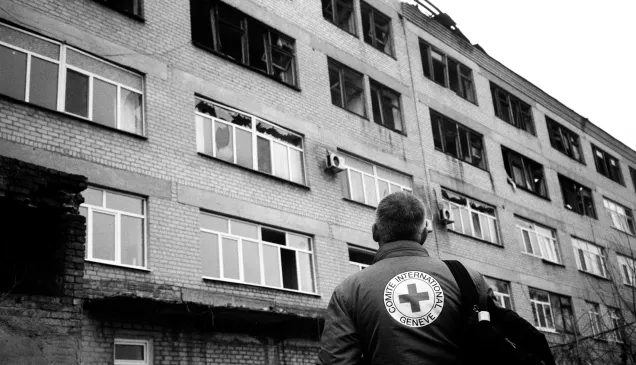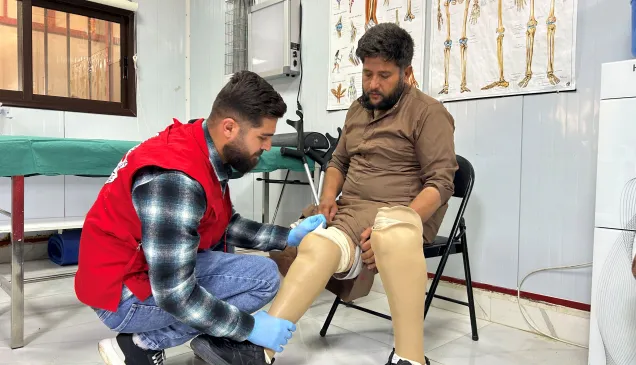The destructive force of war in cities, the suffering it causes and the impact on people's lives and livelihoods – is a major concern of the ICRC in many countries in which we work.
This keynote speech was given by ICRC President Peter Maurer as part of the ICRC's Research and Debate cycle on "War in Cities", 4 April 2017 at the Graduate Institute, Geneva.
We know that many of the world's conflict-affected cities - from Aleppo to Donetsk, from Gaza to Mogadishu, from Aden to Tripoli – are struggling to survive.
For centuries, wars were predominantly fought across vast battlefields, pitting thousands of men, large army corps and heavy weaponry against each other in open fields. Cities could be besieged or sacked but fighting rarely took place on the streets. Today's armed conflicts look quite different: city centers and residential areas have become the battlefields of our time. Wars have moved into the lives, cities and homes of ordinary people in a more vicious way than ever before.
The more we can do to understand urbanisation and its challenges and complexities, the better we can adjust our humanitarian response.
Two thirds of the global population is predicted to be living in cities by 2030, and urban centres are under pressure as they struggle to absorb this rapid increase.
At the same time, armed conflicts are increasingly fought in urban environments with some 50 million people bearing the brunt of the consequences.
A staggering 96% of urban growth is expected to take place in developing countries in cities that already face fragility.
Out of the 65 million people who are forcibly displaced, 75% live in urban areas.
When wars are fought in cities, the vital infrastructure that makes communities function is damaged or destroyed. There is often no safe water to drink, electricity to power homes and businesses, or health services to vaccinate or cure disease. Health and humanitarian workers are deliberately attacked, and people are forced to leave looking for safety.
ICRC recently completed a report, drawing on 30 years of evidence, to analyse the humanitarian response in urban areas and the progressive deterioration of essential services during protracted armed conflicts.
The report showed, to a considerable extent, the problems stem from the complexity of urban systems and their dependence on large-scale, interconnected infrastructures that rely on the availability of qualified staff to ensure service delivery.
When a city is under fire, educational and employment opportunities are lost. As a result, large numbers of people are internally displaced or seek refuge in neighbouring countries, overburdening the capacities of the host city's infrastructure. It also leads to a 'brain drain' effect as specialist skills of engineers, urban planners and medical staff are lost.
The impact after decades of fighting
When wars drag on for many years, they become a major source of human suffering and a cause of displacement, migration and development reversals. The impact is severe on the people, the infrastructure and economies of cities.
Humanitarian assistance was once thought of as a short-term relief effort but is increasingly a longer-term necessity in protracted armed conflicts.
ICRC works simultaneously to address immediate needs as well as the future health, water, livelihood and protection systems that ensure people's survival and dignity.
We fix and set up water supply infrastructure destroyed by war, we support health facilities like hospitals and orthopedic centers or bring in mobile health clinics, we train locals to develop skills and not rely on foreign experts; and we help people start sustainable small businesses through cash grants. For example in Syria alone, the ICRC is maintaining essential water, waste management and energy infrastructure for 18.5 million people.
But ICRC does not stop at mitigating the impact of violence on urban populations; we focus as much on how wars in cities are conducted and the limits that must be placed on armed actors and their conduct in order to shrink the needs of people exposed to urban warfare.
Most people killed in urban conflict are civilians
Logic follows that where there are more people and more weapons, there are more victims. An overwhelming percentage of people killed or injured by explosive weapons in populated areas are civilians. Civilians, not military targets. These are people who are not taking part in the conflict. They are mothers and fathers and children who are not part of the fight and simply wish to lead their lives without the constant threat of bombs or gunfire.
The Geneva Conventions and International Humanitarian Law speak very clearly to the obligation during armed conflicts to protect the civilian population and civilian objects. The specific challenges posed by urban warfare should be taken into account: armed forces need to be prepared to address such challenges considering the overarching objective of the laws of war – which is to protect civilians.
Explosive weapons, which have a wide impact area, have a significant likelihood of indiscriminate effects when used in densely populated areas. These include large bombs, imprecise artillery, multi-barrel rocket launchers and certain types of improvised explosive devices.
In their urban operations, armed forces have to take into account the vulnerability of large numbers of people due to their dependence on urban services and the intricacy and interconnectedness of these essential services.
They must avoid or minimize harm to civilians, including in their choice of means and methods of attack.
In addition to the high risk of incidental civilian death, injury and disability, heavy explosive weapons tend to cause extensive damage to critical civilian infrastructure, triggering debilitating "domino effects" on interconnected essential services such as health care, water and electricity supply systems.
Current and recent armed conflicts – such as those in Syria, Ukraine, Afghanistan, Yemen, Iraq and Gaza – have exposed the particularly devastating effects on civilians of the use of heavy explosive weapons in populated areas.
This impact in turn provokes further civilian death and displacement. And these effects are exacerbated, when wars are long and drawn out.
ICRC is not blind to the difficulties of the battlefield. Notably, too often, an enemy will hide and fight in populated areas and endanger the civilian population, a practice which is prohibited under IHL. The anonymity of big urban areas supports the unfortunate strategy of human shields, which is often at the origin of a vicious cycle of behaviour leading to the disrespect of the law.
The multiplicity of roles individuals can take – from daylight civilian to night-time fighter and back – adds to the complexity of a battlefield, in which civilian and military areas are increasingly intertwined.
Our call for limits to the fighting
ICRC works to remind all parties to take precautions – in peacetime and in conflict - to protect their people, and avoid situating military objects within or near densely populated areas, not to not use the civilian population to shield military activities and not to behave in a way, which exposes civilians to risks.
Military commanders have to face these challenges and have the responsibility to minimize the incidental effects on civilians of an attack. And in view of the devastating humanitarian consequences observed by the ICRC in such kind of situations, serious questions are raised on how armed forces are interpreting and concretely implementing in their military processes the relevant obligations of international humanitarian law.
The onus is on them to explain their choices, notably their choice of weapons, when they conduct hostilities in populated areas. While in the military there is often a lack of specific guidance on the choice of weapons in urban operations, some good practices exist and need to be shared and discussed. Unsurprisingly, with more detailed rules for military commanders, ICRC has a discussion with senior commanders, who feel unduly hampered by the multiplicity of restricting rules in achieving their military objectives in fighting an adversary, who does often not respect those rules.
The intricacies of asymmetric warfare are particularly difficult to manage in such environments; the balance between military necessity and protection of civilians particularly complicated to find in situations of imbalance.
We see this debate as one of the entry points through which the non-reciprocal character of the rules of IHL is challenged by the asymmetry of many conflicts and by demands to consider reciprocity of behaviour when making judgements under IHL. The debate on the use of force in fighting terrorism (or the war on terror as some call it) is rooted in such complexities of urban battlefields.
There is another aspect to consider in this debate: With massive impact of warfare in urban areas widely communicated due to social media and the prevalence of smartphones, there is at least in one part of global public opinion a tendency to consider any civilian victim of armed conflict as a result of violations of IHL. In other parts of the public populist demands for more intensified warfare and no restraining rules in fighting terrorism is condoning torture, indiscriminate bombings and targeted killings.
This polarization of public opinion around IHL has been recognized by the most recent study on people in war. While many support IHL and its protective role, a notable group of people in Europe and the US support the departure from a more balanced approach.
The underlying principle in all of this discussion can never be forgotten: foremost it is civilians who must be protected and all should err on the side of their protection. It is on this premise that the ICRC is calling on all parties to armed conflicts to avoid the use of explosive weapons, which have a wide impact area in densely populated areas. But I would add that it is first and foremost the dimension of suffering of civilians in complex, interconnected urban areas, which eventually has to lead States and other armed actors, to rethink military strategy in densely populated areas.
Some of the most extreme suffering in armed conflicts in today's towns and cities is experienced by people living under siege. The price of civilian victims is simply too high in the dynamics we are witnessing today.

When neighbourhoods are under siege
IHL sets out clear rules about humanitarian conduct that are relevant to siege. These rules must be respected, further elaborated and refined to avoid starvation and the collapse of health and water services generating severe humanitarian consequences for besieged populations. Humanitarian workers need better access to repair damaged infrastructure, days of tranquillity are needed to be able to substitute the lack of services, safety zones around hospitals need to bring minimal stability to the most vulnerable. Negotiations must allow for the disentanglement of civilians and fighters.
The utmost care is needed during evacuations of people from cities under siege. In urban environments there can be a multiplicity of groups controlling different territories; the frontlines change and multiply, all of which increases difficulty of contact, security guarantees and access.
Last December, the ICRC working with the Syrian Arab Red Crescent, in its role as a neutral intermediary evacuated 35,000 people from devastated Eastern Aleppo to rural neighborhoods. The streets of Aleppo have been devastated by violence, with families struggling for months to find safety, food, medical care or shelter. With temperatures below freezing, people were burning whatever they could find, including blankets and clothes, to keep themselves and their children warm. More than 100 SARC volunteers and ICRC staff remained by their side day and night over the week to ensure their safety and try to provide some guidance and reassurance.
In particular this huge operation required careful negotiations with the different parties on the ground. Negotiations were held over a week and stalled several times until solid guarantees were given to ensure civilians would be protected and provided a safe passage.
The impact of protracted fighting on people's lives
So you can see the complexity of today's conflicts. People who survive urban warfare have no choice but to adapt to extraordinary circumstances, whether they stay in their home cities or decide to flee. But they urgently need better protection and support. The mental, emotional and physical impact of urban warfare on people requires greater attention to work out how best to alleviate and prevent this suffering.
The invisible scars that people are left with are can not be underestimated. Wars affect people in very deep and profound ways. While it is difficult to predict the long term impact of those who live in warzones, for example the children of Mosul, it is likely to have severe effects which we should not overlook.
Just a month ago I was in Eastern Ukraine, the second time I have visited since fighting broke out almost three years ago.
The armed conflict in the Donbass is taking place in a highly populated areas. The vital infrastructure which hundreds of thousands of people depend on for their survival are on the frontline of the fighting. Donetsk, once an industrial hub and one of the largest cities in Ukraine, has seen heavy shelling, civilian fatalities and homes destroyed.
What I saw there was a weariness of the people who have lived now for so long in fear, without reliable basic services. In almost every interaction I have had, what was apparent was intense frustration and despair that people feel, of being faced with an increasingly long conflict and no clear way out.
In all my discussions with politicians, senior officials and our staff in Ukraine, it became clear just how deep a division the conflict has driven through society. No-one is left untouched. One of the saddest places I visited was a kindergarten, which was right on the front line at the beginning of the conflict. The kindergarten, once a place of learning and the high spirits of children, today sits abandoned. I saw children's books scattered and dirtied on the floor, right where they fell when the shells hit. At one time, the basement of the kindergarten was used as a bomb shelter, with over 60 people hiding in the darkness from the terror outside.
It was a stark reminder of how everyday life is torn apart during conflict. People must pass through checkpoints, sometimes queuing for hours or even days. Children stop attending schools. Medicine are hard to find and electricity and food supplies are unreliable. Life is so hard, so tenuous for so many.
We at ICRC are listening to people like those in the Donbass and we are doing our best to change our humanitarian responses to meet their needs.
For example, after the Donetsk Filtration Station was damaged in fighting, ICRC worked to address that critical need. With 40,000 people without with clean drinking water the situation is now critical. At the beginning of the March, ICRC, as a neutral intermediary, asked for a reinforced cease-fire in order to allow for the area to be demined and for the filtration plant employees to repair the damage. In the meantime, ICRC teams has started delivering drinking water to residents.
Fragile cities on the brink of conflict
There is a second and related trend occurring in cities that we must pay close attention to as we adjust our response.
The rapid urbanisation we are seeing is creating fragile cities — places like Bamako and Caracas — where violence is accelerating, fueled by the drug trade, mass unemployment and civil unrest.
It is not outright war, but plain violence that kills in those cities, which enter the vicious circle of fragility, violence, and, possibly, conflict. In some of the most violent cities in Latin America as many people died by firearm violence as in Syria – a country at war.
Many large cities of South Asia, Africa and Latin America are already suffering the consequences of rapid and unregulated expansion – most visibly in neglected and violence-affected slums and shantytowns.
The correlation between urbanization and violence is unquestionably a complex one, with many factors at play, such as social inequality, unequal distribution of resources, lack of investment, low levels of education and high unemployment. This is particularly troublesome as we know that an increasing percentage of global wealth comes from economic growth in urban areas. Urban violence therefore does not only endanger people's lives but also potentially affects the global economy.
More than 1.5 billion people, including 350 million of the world's extreme poor, live in an environment of continuous fragility, violence and conflict. That's a huge number of people at risk – it's reported that ten times more people die outside of conflict than in times of conflict.
And the lines between violence and armed conflict are increasingly blurred. ICRC works to reduce this fluidity through legal guidance – but what we know is that violence contributes to fragility, and that fragility can quickly lead to conflict.
As this is an area of keen interest for me, I will share one story of how ICRC is working to reduce armed violence with those who live in the favelas in Rio de Janeiro.
I'm told about a mother of four living in a violent slum whose husband suddenly disappeared without trace. She had been struggling to provide for herself and her children and worries constantly about their safety. The constant stress makes the woman ill, yet she is unable to get the psychological support or care she needs. The violence has caused the nearby health clinic to close and made health-care workers afraid to enter the neighbourhood.
For five years now ICRC has been partnering with Brazilian government agencies, neighborhood associations and the Brazilian Red Cross. The Rio Project is having good success helping people, like this mother who live with the psychological scars of violence access better healthcare and mental health services.
Solutions in cities need everyone
As with the Rio Project, partnerships are key to ICRC's approach, whatever the situation. At all times ICRC adopts a neutral, independent and impartial stance. We aim to be pragmatic and innovative, tailored to the specific needs of the affected communities and the particular dynamics of each context.
Primarily we must fully involve the people and communities affected by violence to really understand their needs, to codesign and implement an effective response that helps bolster their resilience, and ultimately to helping ensure the sustainability of programmes.
The ICRC also works closely with local service providers, connecting them with vulnerable people and communities to facilitate safer access to basic services. We work with the true frontline responders in urban violence settings – National Red Cross and Red Crescent Societies, civil society organizations and local authorities to design an appropriate integrated response. We also work with mayors, urban planners and police and the private sector. All groups that are responsible for the positive functioning of urban life need to be involved.
At a global level we are adapting to the long-term humanitarian needs that protracted conflicts create. But this means that international donors must adapt too: additional, multiyear funding for the long-term work of the few humanitarian actors present in warzones is crucial to ensure the basic minimum needed for the survival of people.
Bringing humanitarians together with stakeholders from the private sector allows us to harness the power and resources of the private sector to support and advance humanitarian work. More ambitious social and economic agendas can only evolve if built on the foundations of stable partnerships with economic operators. This is one of the reasons ICRC is working with the World Economic Forum's Global Agenda Council on Fragility, Violence and Conflict to find solutions to increase resilience in urban conflict zones.
ICRC has also been working through global mechanisms like the New Urban Agenda and Habitat III, to provide clear policy guidance on urban humanitarian action for national governments and city authorities in the next 20 years. This guidance will be important in situations when municipal authorities need to partner with the ICRC and other humanitarian organizations to protect and assist their city's population, and build essential urban services that are resilient in bad times as well as good times.
There is probably no other context through which warfare and violence in urban areas are so clearly visible as in some of the cities in Yemen: While war and violations of IHL have taken their toll, at the same time violence and conflict have slowly killed economic activities, which are so essential to the survival of populations. With both trends combined, we end up, with what we have.
Massive disruption of the economic, political and societal fabric and the virtual impossibility of humanitarian actors, to substitute themselves to inexistent economic activities and social services for a whole population.
The mark of a resilient city should be its commitment to human dignity - for all who reside there.
While these are challenging times, we can never abandon those who live with conflict on their doorstop. We can never stop striving to find solutions for those kindergarten students in Eastern Ukraine, for the families struggling to feed their children in Gaza or Mosul or those in Aleppo making the impossible decision to stay or go.
All parts of communities need to do better to protect people. Armed forces and military groups need to exercise the utmost precaution in their attacks, city authorities must look to build cities that will withstand disaster, and private sector investment need to similarly adapt.
The complexity of the issue is so great that it requires a response, a new methodology, from the international community that perhaps we have never seen before.
My call is for us to work together to reduce violence and help cities and communities better cope with fragility, we can mitigate the effects of wars on people. This, ultimately, is our mission.



